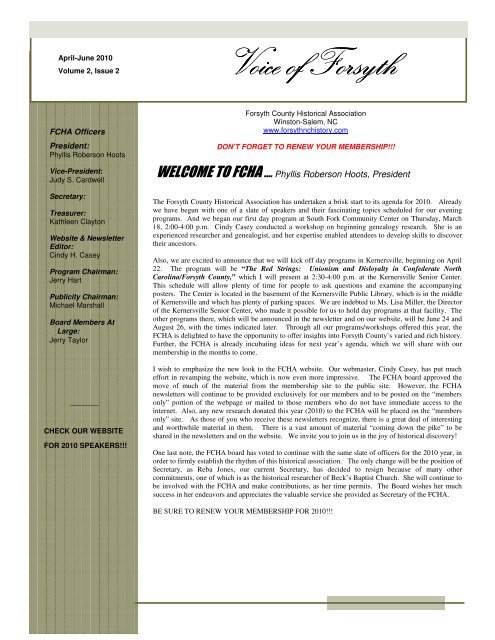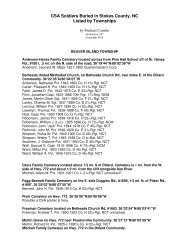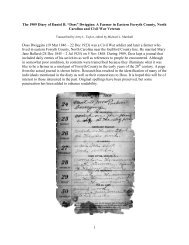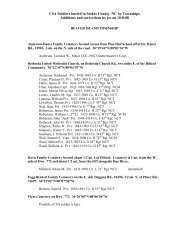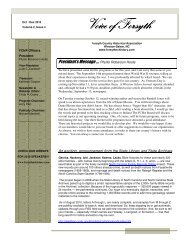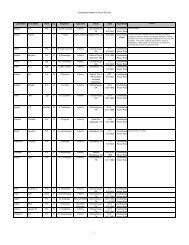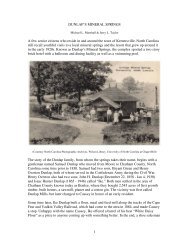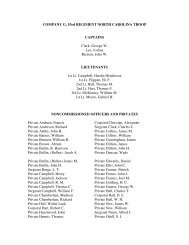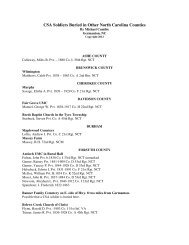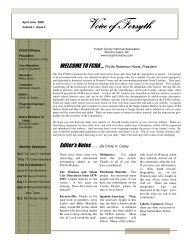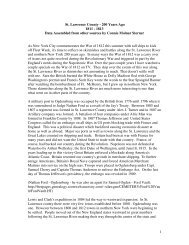Voice of Forsyth - Forsyth County Historical Association
Voice of Forsyth - Forsyth County Historical Association
Voice of Forsyth - Forsyth County Historical Association
You also want an ePaper? Increase the reach of your titles
YUMPU automatically turns print PDFs into web optimized ePapers that Google loves.
April-June 2010<br />
Volume 2, Issue 2<br />
<strong>Voice</strong> <strong>of</strong> <strong>Forsyth</strong><br />
FCHA Officers<br />
President:<br />
Phyllis Roberson Hoots<br />
Vice-President:<br />
Judy S. Cardwell<br />
Secretary:<br />
Treasurer:<br />
Kathleen Clayton<br />
Website & Newsletter<br />
Editor:<br />
Cindy H. Casey<br />
Program Chairman:<br />
Jerry Hart<br />
Publicity Chairman:<br />
Michael Marshall<br />
Board Members At<br />
Large:<br />
Jerry Taylor<br />
_______<br />
CHECK OUR WEBSITE<br />
FOR 2010 SPEAKERS!!!<br />
<strong>Forsyth</strong> <strong>County</strong> <strong>Historical</strong> <strong>Association</strong><br />
Winston-Salem, NC<br />
www.forsythnchistory.com<br />
DON’T FORGET TO RENEW YOUR MEMBERSHIP!!!<br />
WELCOME TO FCHA …. Phyllis Roberson Hoots, President<br />
The <strong>Forsyth</strong> <strong>County</strong> <strong>Historical</strong> <strong>Association</strong> has undertaken a brisk start to its agenda for 2010. Already<br />
we have begun with one <strong>of</strong> a slate <strong>of</strong> speakers and their fascinating topics scheduled for our evening<br />
programs. And we began our first day program at South Fork Community Center on Thursday, March<br />
18, 2:00-4:00 p.m. Cindy Casey conducted a workshop on beginning genealogy research. She is an<br />
experienced researcher and genealogist, and her expertise enabled attendees to develop skills to discover<br />
their ancestors.<br />
Also, we are excited to announce that we will kick <strong>of</strong>f day programs in Kernersville, beginning on April<br />
22. The program will be “The Red Strings: Unionism and Disloyalty in Confederate North<br />
Carolina/<strong>Forsyth</strong> <strong>County</strong>,” which I will present at 2:30-4:00 p.m. at the Kernersville Senior Center.<br />
This schedule will allow plenty <strong>of</strong> time for people to ask questions and examine the accompanying<br />
posters. The Center is located in the basement <strong>of</strong> the Kernersville Public Library, which is in the middle<br />
<strong>of</strong> Kernersville and which has plenty <strong>of</strong> parking spaces. We are indebted to Ms. Lisa Miller, the Director<br />
<strong>of</strong> the Kernersville Senior Center, who made it possible for us to hold day programs at that facility. The<br />
other programs there, which will be announced in the newsletter and on our website, will be June 24 and<br />
August 26, with the times indicated later. Through all our programs/workshops <strong>of</strong>fered this year, the<br />
FCHA is delighted to have the opportunity to <strong>of</strong>fer insights into <strong>Forsyth</strong> <strong>County</strong>’s varied and rich history.<br />
Further, the FCHA is already incubating ideas for next year’s agenda, which we will share with our<br />
membership in the months to come.<br />
I wish to emphasize the new look to the FCHA website. Our webmaster, Cindy Casey, has put much<br />
effort in revamping the website, which is now even more impressive. The FCHA board approved the<br />
move <strong>of</strong> much <strong>of</strong> the material from the membership site to the public site. However, the FCHA<br />
newsletters will continue to be provided exclusively for our members and to be posted on the “members<br />
only” portion <strong>of</strong> the webpage or mailed to those members who do not have immediate access to the<br />
internet. Also, any new research donated this year (2010) to the FCHA will be placed on the “members<br />
only” site. As those <strong>of</strong> you who receive these newsletters recognize, there is a great deal <strong>of</strong> interesting<br />
and worthwhile material in them. There is a vast amount <strong>of</strong> material “coming down the pike” to be<br />
shared in the newsletters and on the website. We invite you to join us in the joy <strong>of</strong> historical discovery!<br />
One last note, the FCHA board has voted to continue with the same slate <strong>of</strong> <strong>of</strong>ficers for the 2010 year, in<br />
order to firmly establish the rhythm <strong>of</strong> this historical association. The only change will be the position <strong>of</strong><br />
Secretary, as Reba Jones, our current Secretary, has decided to resign because <strong>of</strong> many other<br />
commitments, one <strong>of</strong> which is as the historical researcher <strong>of</strong> Beck’s Baptist Church. She will continue to<br />
be involved with the FCHA and make contributions, as her time permits. The Board wishes her much<br />
success in her endeavors and appreciates the valuable service she provided as Secretary <strong>of</strong> the FCHA.<br />
BE SURE TO RENEW YOUR MEMBERSHIP FOR 2010!!!
Vol. 2 Issue 2 FCHA Page 2 <strong>of</strong> 13<br />
VISIT WINSTON-SALEM: Frequently Asked Questions— This little website <strong>of</strong>fers great information about the City <strong>of</strong><br />
Winston-Salem. A quick trivia game could be enjoyed from the explanations <strong>of</strong>fered to the many questions frequently asked<br />
about our community. http://www.visitwinstonsalem.com/visitor_center/vis_faqs.html<br />
Carolina Music Ways Music Heritage Resource Group (CMW) is a grassroots group <strong>of</strong> area citizens from the Yadkin<br />
Valley region <strong>of</strong> northwest North Carolina—one <strong>of</strong> the most musically rich areas <strong>of</strong> the United States. CMW serves as the<br />
region's primary source <strong>of</strong> information on the area's musical heritage and on current-day musicians and events that keep area<br />
music traditions alive. We focus on bluegrass, jazz, blues, gospel, old-time string band, and Moravian music. CMW was<br />
established in 2003 as a North Carolina nonpr<strong>of</strong>it organization. Our work is made possible thanks to technical support<br />
provided by the Northwest Piedmont Council <strong>of</strong> Governments, as well as funding from The Winston-Salem Foundation, the<br />
North Carolina Arts Council, and the Arts Council <strong>of</strong> Winston-Salem and <strong>Forsyth</strong> <strong>County</strong><br />
http://www.carolinamusicways.org/about.html<br />
MORAVIAN MUSIC FOUNDATION: Among the rarities in the MMF collections are the only known complete set <strong>of</strong> band<br />
books from a Confederate band in the American Civil War. These were brought to Salem because the 26 th NC Regimental<br />
Band C.S.A. was comprised wholly <strong>of</strong> Moravian musicians from Salem. For more information about the MMF collections or to<br />
order a recording <strong>of</strong> the Civil War music, go to their website http://www.moravianmusic.org/<br />
VISIT WINSTON-SALEM- 2010 Calendar <strong>of</strong> Events--http://www.visitwinstonsalem.com/visitor_center/vis_calendar.asp#/i=1<br />
Stepping Stones <strong>of</strong> Progress….continued<br />
Saturday Evening, May 4, 1935 Winston-Salem Journal:<br />
1912: Over 500 buildings: <strong>County</strong> Reformatory, N. Winston and East Winston Baptist Churches, Trinity<br />
and Immanuel Moravian, Salem Town Hall and Fire Station, the First Presbyterian Church enlarged, lot<br />
bought for Fries Memorial Church; Ogburn Hill factory burned; Water works dam washed away, and<br />
Salem Creek highest ever known.<br />
1913: Southern Public Utilities Co. purchased Fries Mfg. & Power Co.—New Buildings: Twin City<br />
Club, <strong>Forsyth</strong> Dining Room Furniture Co., West End Methodist Church, Home Moravian Church rebuilt,<br />
Methodist protestant Church remodeled and Friends bought and improved church on Patterson Ave.—<br />
Income tax amendment passed<br />
1914: More new buildings: Granville School, Fries Memorial Church, Export Leaf Co., City Hospital—<br />
Among those added to or improved: West End School, Children’s Home, Centenary Methodist Church,<br />
Hanes Mills—20 miles <strong>of</strong> good roads built and repaired--$40,000 raised for YWCA building- East<br />
Winston Band organized<br />
Wachovia Bank & Trust<br />
Winston-Salem, NC<br />
1915-Business homes built: O’Hanlon building, Morris & Co., Red C Oil Co., Farmers Union, Atkins<br />
Hall at Slater School, Motor Co. rebuilt Gilmer store into a garage, P.H. Hanes Co. added a spinning mill<br />
at Hanestown—Considerable road work was done in the county.<br />
1916- Notwithstanding war, progress continues: Winston-Salem made a port <strong>of</strong> entry—New buildings:<br />
Grace Church, Tuberculosis Hospital, A.S. Hanes Rubber Tire Plant and N&W RR- Sesque-Centennial<br />
founding <strong>of</strong> Salem.<br />
1917- US declared war against Germany—Over four million subscribed for Liberty Loan—Reynolds<br />
Co. erected three new buildings; Some others: New Auditorium, Liberty Storage, Kress Store, Salem<br />
Baptist Church—Additions made to Zinzendorf Hotel<br />
1918- Great Flu Epedimic- Riot and attempted lynching-$110,000 raised for Red Cross- Remaining<br />
cedars in avenue taken down and oaks planted.
Page 3 <strong>of</strong> 13<br />
FCHA Vol. 2 Issue 2<br />
DID YOU KNOW<br />
By Kathleen Clayton<br />
According to the web site www.city-data.com, Winston-Salem’s historical earthquake activity is significantly above the North<br />
Carolina state average. Fortunately they also report that it is 86% smaller than the overall US average. There could be<br />
another way to look at it. There may have been more earthquakes reported because <strong>of</strong> the records kept by the Moravians.<br />
An interesting entry in the Bethabara Diary from February 21, 1774 states “Today at three o’clock there was an earthquake.<br />
The bells hanging in the store all rang at the same time. I was in the yard and thought a large herd <strong>of</strong> cattle was coming. It<br />
was felt in all houses, but not severely enough for all to notice it.”<br />
On the same day in 1916 the Winston-Salem Journal reported that “the shock was felt in Winston-Salem and <strong>Forsyth</strong><br />
<strong>County</strong>, but the tremor was only slight and no damages reported. Citizens residing on Summit Street and in other sections<br />
<strong>of</strong> the city report that they felt the shock. Windows were rattled and other things about the houses in the city evidenced the<br />
shock. One lady reported that the shock here lasted about a minute. Old Town and the village <strong>of</strong> Hanes reported that the<br />
shock was felt there as well. Indeed, it was evidently felt generally over the county. It seems the shock was made noticeable<br />
by the rattling windows and dishes as the people who were on the street at the time did not notice the tremor.”<br />
FAMILYHISTORY101.com: Features a rotating animated map showing all the North Carolina county<br />
boundary changes and all the county boundaries for each census year overlaid with past and present maps<br />
so you can see the changes in county boundaries. http://www.familyhistory101.com/maps/nc_cf.html<br />
The <strong>Historical</strong> Archaeology <strong>of</strong> Early African Americans in the Moravian town <strong>of</strong> Salem; North Carolina<br />
http://www.cas.sc.edu/anth/faculty/LGFergus/Ferguson.html<br />
DIGITAL LIBRARY ON AMERICAN SLAVERY<br />
http://library.uncg.edu/slavery/history.aspx<br />
Underwritten by a "We the People" grant from the National Endowment for the Humanities, The Digital Library on American Slavery is<br />
a cooperative venture between the Race and Slavery Petitions Project and the Electronic Resources and Information Technology<br />
Department <strong>of</strong> University Libraries at The University <strong>of</strong> North Carolina at Greensboro. The Digital Library <strong>of</strong>fers a searchable database<br />
<strong>of</strong> detailed personal information about slaves, slaveholders, and free people <strong>of</strong> color. Designed as a tool for scholars, historians, teachers,<br />
students, genealogists, and interested citizens, the site provides access to information gathered and analyzed over an eighteen-year period<br />
from petitions to southern legislatures and country courts filed between 1775 and 1867 in the fifteen slaveholding states in the United<br />
States and the District <strong>of</strong> Columbia<br />
Established in 1991, the Race and Slavery Petitions Project was designed to locate, collect, organize, and publish all extant legislative<br />
petitions relevant to slavery, and a selected group <strong>of</strong> county court petitions from the fifteen former slaveholding states and the District <strong>of</strong><br />
Columbia, during the period from the American Revolution through the Civil War. Between 1991 and 1995, the Project Director and<br />
editor, Loren Schweninger traveled across the South to photocopy and micr<strong>of</strong>ilm petitions meeting that criterion. During the initial three<br />
years, he visited fourteen state archives and about one hundred and sixty county courthouses. In subsequent years, he added to the<br />
collection: 945 Orleans Parish petitions in 1998; 200 petitions from records <strong>of</strong> Louisiana Supreme Court (various parishes) in 1999; 53<br />
Boone <strong>County</strong>, and 149 St. Louis, Missouri, petitions in 2000; 84 Shelby <strong>County</strong>, Tennessee, petitions in 1998 and 2000; and 71<br />
Noxubee <strong>County</strong>, Mississippi, petitions in 2001. With the exception <strong>of</strong> 563 NC county court petitions, selected from five discrete record<br />
sets by experienced research assistants, the director chose all <strong>of</strong> the documents.<br />
The Project now holds 2,975 legislative petitions and approximately 14,512 county court petitions. The massive number <strong>of</strong> surviving<br />
relevant county court petitions, estimated to be more than a quarter <strong>of</strong> a million, is dispersed in state archives and county courthouses<br />
across the South.
Vol. 2 Issue 2 FCHA Page 4 <strong>of</strong> 13<br />
STOCKTON’S INN<br />
By Michael Marshall<br />
In earlier days, taverns and inns dotted the landscape <strong>of</strong> what is now <strong>Forsyth</strong> <strong>County</strong>. Of these, the Salem tavern is perhaps the best<br />
known. Another was William Dobson’s tavern located in the crossroads village that is now Kernersville. Less well known is that about a<br />
mile west <strong>of</strong> Kernersville there stood another public house known as Stockton’s Inn. It was owned by Doughty Stockton and his wife<br />
Elizabeth Perkins. Doughty, a member <strong>of</strong> the prominent Stockton family <strong>of</strong> New Jersey, is the ancestor <strong>of</strong> the Stockton lines <strong>of</strong> both<br />
Kernersville and Winston-Salem. He is a descendant <strong>of</strong> Richard Stockton who came from England to Flushing, Long Island prior to<br />
November 8, 1656. Doughty himself was born June 8, 1776 in Princeton, New Jersey, the son <strong>of</strong> Daniel and Mary (Clayton) Stockton. His<br />
grandfather was Joseph Stockton whose wife was Elizabeth Doughty, a fact that accounts for the presence <strong>of</strong> that name in the Stockton<br />
line in subsequent generations.<br />
Doughty Stockton began operating his inn some time before 1810. It was located approximately a mile west <strong>of</strong> Kernersville on the old<br />
road to Salem (now called Kernersville Road). It appears on the MacRae-Brazier map <strong>of</strong> North Carolina published in 1833, where is<br />
simply labeled “Stockton’s.” From all accounts, Stockton’s Inn was a popular stopping-place in its day, and both Doughty and his wife<br />
were well-liked innkeepers. For many years, the cook at the inn was an old Negro woman called “Aunt Nany.” This bit <strong>of</strong> information<br />
comes from an interesting piece that appeared in the People’s Press <strong>of</strong> Salem on October 18, 1833. It was written by Kernersville’s<br />
Moravian Minister at the time, the Reverend C. Lewis Rights, a sometime correspondent for the paper:<br />
Mr. Jeremiah Hester brought some fine turnips to town the other day as big as dinner plates, grown in an old field. He broke it up in the<br />
spring, and every time he plowed he plowed this patch over too, and about the 1 st <strong>of</strong> August he sowed his seed with some fertilizer, and<br />
this is the result. We got some <strong>of</strong> them, and “Aunt Nany Kerner,” an old colored woman, was at our house that day, and so we got her to<br />
cook them; and if there is anything that she can cook to perfection it is turnips; we ate and ate until we had to quit; and then like the little<br />
boy with the plum pudding, we wanted to cry because we could not eat any more. “Aunt Nany” used to belong to “Old Mr. Doughty<br />
Stockton,” who kept a wayside hotel between here and Salem in the “olden time,” which had an almost world wide reputation for the good<br />
fare provided for the guest, and Nany sticks to “Old Misses ways,” like a cuckleburr, but her grand culinary triumph consist in cooking<br />
turnips.<br />
After operating the inn for nearly a half century, Doughty passed away on December 29, 1855. His People’s Press obituary contains<br />
this comment about the inn: “While his long useful and laborious life for the last forty-seven years was devoted to serving the public as a<br />
Landlord, with the noblest impulses and with a sensibility alive to the tenderest wishes <strong>of</strong> the weary traveler, his influence was ever<br />
exerted to render them comfortable and happy. He always discharged his duties with a dignity and propriety <strong>of</strong> conduct, which conciliated<br />
regard and secured for him the love and esteem <strong>of</strong> all who knew him.”<br />
Doughty’s wife Elizabeth followed him to the grave on March 27, 1857. Her obituary from the same paper had this to say: “Many<br />
travelers will long remember her kindness. For a long series <strong>of</strong> years her husband kept a public house, and she manifested the rare tact<br />
<strong>of</strong> making every one who came about her comfortable and happy.” Both Doughty and Elizabeth are buried in the old Muddy Creek or<br />
Union Quaker Cemetery, located today inside the Kernersville city limits.<br />
DESERTIONS DURING THE CIVIL WAR…. con’t<br />
Many positive remarks were received concerning the article on Desertions during the Civil War featured in our last<br />
newsletter. Thank you all for your feedback! The following article was submitted by FCHA member Mike Marshall:<br />
During the Civil War, Richard P. Kerner was a captain in NC Confederate militia/homeguard and was sometimes involved in rounding up<br />
deserters from the Army. The militia letter book contains this letter from the Confederate Adjutant General to Capt. R. P. Kerner dated 18<br />
June 1863.<br />
"Received yours <strong>of</strong> 10th inst. You can call on militia in any district to aid in arresting deserters, etc. If deserters are, or you suspect them to<br />
be hiding in their homes, 'it is your duty to go in and arrest them.' 'Men claiming exemptions from disability must comply with the orders<br />
issued from this <strong>of</strong>fice, unless in your opinion they are not able, in which case you will grant them furlough till they hear from me;
Page 5 <strong>of</strong> 13<br />
FCHA Vol. 2 Issue 2<br />
otherwise you will see that they are put on duty.' Should they refuse, arrest them & report through your colonel to me that they may be<br />
punished. Persons who have furnished substitutes in Confederate service are not exempt from the militia. Government contractors are<br />
exempt so long as they comply with law."<br />
According to the book "North Carolina Civil War documentary," edited by W. Buck Yearns and John G. Barrett, "Even in counties where<br />
militia and home guard units were capable <strong>of</strong> apprehending deserters, [NC Governor Zebulon B.] Vance found his efforts hampered by<br />
Richmond M. Pearson. The [NC Supreme Court] chief justice issued many writs <strong>of</strong> habeas corpus freeing such captives on the ground<br />
that enforcement <strong>of</strong> the conscription laws was the task <strong>of</strong> the Richmond and not the Raleigh government. Vance wrote President Davis<br />
that Pearson's direction 'went abroad to the army in a very exaggerated and ridiculous [sic] form. Soldiers were induced to believe that it<br />
declares the conscript law unconstitutional, and that they were entitled, if they came home, to the protection <strong>of</strong> their civil war authorities.'<br />
In the words <strong>of</strong> General W. D. Palmer 'the whole trouble lies in the fact that they believe when they get into North Carolina they will not be<br />
molested, and their belief is based upon the dictum <strong>of</strong> Judge [R. M.] Pearson . . . Vanc, nevertheless continued to use the home guard to<br />
find deserters until finally in July 1863, the General Assembly gave him formal authority to do so and made it a high misdemeanor to aid<br />
or harbor deserters."<br />
[Extracted from the Weekly Standard, a newspaper published in Raleigh North Carolina, and was published in the paper at Pearson's<br />
request on 1 April 1863, and reveals how Pearson reasoned that one might harbor a deserter with impunity. It involves the arrest <strong>of</strong> one<br />
deserter named Chordy Whiteheart by Capt. Richard P. Kerner. Whiteheart probably lived in Guilford <strong>County</strong>.]<br />
2010--FCHA SPEAKERS & SPECIAL PROGRAMS<br />
Saturday, April 10- Loves United Methodist Church – 10am – 2:30 pm- Please join us for a fun-filled day <strong>of</strong> family history and genealogy. Featured<br />
families include MARSHALL, SOUTHERN and WAGGONER, but there will also be information on the CARMICHAEL, WESTMORELAND, CREWS,<br />
DWIGGINS and WEST families. Show and Tell Sessions- for more information contact Mike Marshall 336-298-4131. (Loves UM Church, 5245 Friendly<br />
Road, Walkertown, NC)<br />
Tuesday, April 13- Reynolda Manor Library, 7 pm—BEV HAMEL-Bev Hamel will be speaking on her newly released book, Bethania: the Village by<br />
the Black Walnut Bottom. Bev left the corporate world <strong>of</strong> sales and marketing <strong>of</strong> major corporations to open an antique shop, write, and return to school.<br />
She graduated Magna Cum Laude from Salem College in 2006 and earned her MFA from Goddard College (Vermont) in 2008. She and her family have<br />
restored four historic properties-- three in Bethania! She is a freelance writer, writes for numerous publications, and is an award-winning poet and essayist.<br />
Bev is a wonderful lecturer and creative writing teacher, as well as history buff and antique collector. Bethania: The Village by the Black Walnut<br />
Bottom was published by The History Press in July 2009. Copies will be for sale! DON’T MISS THIS!<br />
Tuesday, April 22- Kernersville Senior Center – 2:30 pm- FCHA Special Presentation<br />
The Red Strings: Unionism and Disloyalty in Confederate North Carolina/<strong>Forsyth</strong> <strong>County</strong><br />
Phyllis Roberson Hoots, president <strong>of</strong> the FCHA, will discuss a secret, pro-Union/anti-Confederacy group called The Heroes <strong>of</strong> America that was active in<br />
NC during the Civil War. Because its members <strong>of</strong>ten wore a red string in their coat lapels, in allusion to the Bible story <strong>of</strong> Rehab, the group was commonly<br />
called the “Red Strings”, or the “Red String Band.” Mrs. Hoots, a lecturer in history at <strong>Forsyth</strong> Technical Community College, is a life-long resident <strong>of</strong><br />
<strong>Forsyth</strong> <strong>County</strong> and an avid researcher <strong>of</strong> <strong>Forsyth</strong> <strong>County</strong> history.<br />
Tuesday, May 11- Reynolda Manor Library, 7 pm- PROF. RICHARD ELLER<br />
Don’t miss your “Flying Lessons”!!! Learn the wonderful history <strong>of</strong> our hometown company, PIEDMONT AIRLINES! Bring your friends and your historybuff<br />
relatives! Presently, Pr<strong>of</strong>. Eller is Department Head <strong>of</strong> Social Sciences <strong>of</strong> Catawba Valley <strong>County</strong> Community College. His published works include :<br />
Piedmont Airline: A Complete History, 2009 winner <strong>of</strong> the NC Society <strong>of</strong> Historians’ “Willie Parker Peace Award” ; The Tarheel Lincoln with Jerry<br />
Goodnight and Speedbird: The History <strong>of</strong> Piedmont Airlines--Video Documentary<br />
Tuesday, June 8 - Reynolda Manor Library, 7 pm - Greg Cheek- "Money used in Salem before and during the Civil War"<br />
Born in <strong>Forsyth</strong> <strong>County</strong>, Greg grew up in a little village called Clemmons and attended Clemmons elementary, Southwest Junior High, and West <strong>Forsyth</strong><br />
High schools. After graduation in 1973, Greg attended NC State, graduating with a Forestry degree in 1978. He later received an Associate degree in<br />
Computer Science from <strong>Forsyth</strong> Technical College. He was employed by Hanes (Sara Lee) until 1998 as a computer programmer and then as a database<br />
administrator. In 1998 he moved to Yadkin <strong>County</strong> with his Wife Lois and children Andrew, Amy, and Anna and started his career with Lowe's Home<br />
Improvement. He is currently involved with the Yadkin <strong>County</strong> <strong>Historical</strong> Society, Yadkin Gray Eagle SCV Camp, 28th NC Troops reenacting group, and<br />
various local and state coin clubs and associations. Greg is currently working on his first book about Johnson's Island, a Confederate Officers' POW camp<br />
located in Ohio. Greg's other hobbies include coin and paper money collecting, local WBTS historical document and cemetery research, and re-enacting<br />
living history portrayal. Don't miss this very informative presentation about the banking situation and the local notable personalities involved in <strong>Forsyth</strong>'s<br />
economy during the Civil War.
Vol. 2 Issue 2 FCHA Page 6 <strong>of</strong> 13<br />
One <strong>of</strong> the best resources for Moravian Church study is the monthly newspaper, The Wachovia Moravian. Over 77 years, from<br />
March 1893 to August 1970 The Wachovia Moravian recorded the life and activities <strong>of</strong> the Moravian Church, Southern Province.<br />
Ministers and missionaries, workers and laity all contributed their portion <strong>of</strong> the historical record as chronicled by The<br />
Wachovia Moravian. Church and secular events, baptisms, marriages, deaths, even advertisements provide a window to the<br />
world as seen by The Wachovia Moravian. The issues from March 1893 through December 1914 were provided courtesy <strong>of</strong> the<br />
North Carolina Newspaper Project <strong>of</strong> the North Carolina Office <strong>of</strong> Archives and History. The remaining issues to August 1970<br />
were micr<strong>of</strong>ilmed from the collection <strong>of</strong> the Moravian Archives, Winston-Salem, North Carolina. Every issue is computer<br />
searchable except for an occasional “white” copy (for example, March 1893). The handwritten dates on many <strong>of</strong> the issues<br />
were kindly provided by the late Burton and Anna Snyder, more widely known as devoted band members <strong>of</strong> Fairview<br />
Moravian Church. It must be remembered that those who wrote for The Wachovia Moravian did so with the most advanced<br />
insight <strong>of</strong> their time, which to our more finely attuned sensibilities may seem quaint or even <strong>of</strong>fensive. But they were doing<br />
their best in presenting the mission field history for such remote lands (at the time) as Nicaragua, Alaska, Southern Africa,<br />
India. We salute them for their pioneer labors.<br />
(Source: The Moravian Archive Website http://moravianarchives.org/churchhistory.html)<br />
Editors Note: This newspaper discloses wonderful historical information about our community and county. There are many great articles <strong>of</strong><br />
historical significance!!!<br />
1897<br />
The Wachovia Moravian<br />
FEBRUARY: On Saturday, February 6, while the six-year old son <strong>of</strong> a Mr. Bullard, employed in the Salem Flour Mill, was endeavoring to cross the<br />
Middlefork Creek on a foot-log near the mill, he fell into the water and was drowned. A most diligent search was made for the body up to the date <strong>of</strong><br />
this writing (15 th ), but so far without finding it. A freshet was prevailing at the time <strong>of</strong> the drowning, which accounts for the fruitless search. The<br />
parents, who live on South Marshall Street, have the heartfelt sympathy <strong>of</strong> our whole community.<br />
The will <strong>of</strong> the late E.T. Clemmons gave his fortune <strong>of</strong> between $50,000 and $100,000 to the Moravian Church, Mrs. Clemmons to have the income<br />
during her life. The Remenyi concert, given for the benefit <strong>of</strong> the Twin City Hospital, was well attended and was a financial success.<br />
MARCH: The extensive renovations in connection with the old Boys’ School house have made the building very attractive. It will, in the future, be<br />
used as an archive depository, and for the purposes <strong>of</strong> the Wachovia <strong>Historical</strong> Society.<br />
A part <strong>of</strong> the old Salem Hotel has been torn down, in order to open up a new street. The portion containing the room which George Washington<br />
occupied while on a visit to Salem is still standing.<br />
The body <strong>of</strong> the little boy, drowned in the Salem Creek, was found , after having been I the water nearly a month. It was well preserved.<br />
Edison’s new invention, the Projectoscope, was shown in Winston and Salem. It represents moving figures, and is a truly wonderful invention.<br />
The Men’s League will move from their present rooms to the Music Hall building. The Museum has been discontinued, part <strong>of</strong> the collection being<br />
given to the Boys’ School, and part to the Wachovia <strong>Historical</strong> Society.<br />
APRIL: The Journal is the name <strong>of</strong> a new paper published in Winston.
Page 7 <strong>of</strong> 13<br />
FCHA Vol. 2 Issue 2<br />
CENTENNIAL CELEBRATION OF FORSYTH COUNTY 1849-1949<br />
by Kathleen Clayton<br />
In 1949, <strong>Forsyth</strong> <strong>County</strong> had a huge celebration for its hundredth anniversary. <strong>Forsyth</strong> <strong>County</strong> came into being on Jan 16,<br />
1849 when the NC Legislature divided Stokes <strong>County</strong> by an east to west line. The county was named after a hero <strong>of</strong> the<br />
Canadian front in the War <strong>of</strong> 1812, Col. Benjamin <strong>Forsyth</strong>. At the time the town <strong>of</strong> Salem was already 83 years old and had<br />
700 inhabitants, a cotton mill, wool mill, church, school, doctors and large number <strong>of</strong> handicrafts. For 64 years the new town<br />
<strong>of</strong> Winston and Salem grew side by side until 1913 when they united under one name. Winston was named in honor <strong>of</strong><br />
Major Joseph Winston <strong>of</strong> Revolutionary War fame.<br />
The festivities for “The First 100 Years Program <strong>of</strong> <strong>Forsyth</strong> Centennial and Piedmont Festival” were varied and numerous. It<br />
began on May 6, 1949 at 7:30pm with the Bushgrowers Costume Jamboree at Glenn’s Warehouse at 900 North Trade St.<br />
The Bushgrower’s League claim to fame was “whisker-gardening” with awards for “flourishing crops <strong>of</strong> facial hair”. Three hill<br />
billy bands, a championship beard contest and a parade <strong>of</strong> beards were scheduled for the evening. Men began growing<br />
beards during the winter but by the end <strong>of</strong> the centennial activities the barbers were busy. According to the May 7, 1949<br />
Winston-Salem Journal, the event was attended by 3,000 people. Minnie Pearl and Rod Brassfield from the Grand Ol’ Opry<br />
Company attended. There were 473 contestants for the various beard contests. Beauty the singing cow performed and she<br />
christened the stage. Minnie Pearl followed the cow performance and she insisted that someone be sure to tell the audience<br />
which was which. Rod Brassfield sang “When the Doctors Operated on My Papa, They Opened My Mama’s Male”. The<br />
party was still going strong after midnight.<br />
On the same night at 8:30 pm, “A Night <strong>of</strong> Opera” was held at Reynolds Auditorium. The event was produced by the<br />
Piedmont Festival <strong>of</strong> Music and Art. An Opera School was established at Salem College in 1941 with Dr. Clifford Bair in<br />
charge. In 1942 it was moved to the Women’s College in Greensboro.<br />
On May 11, 1949 at 8:30 pm, a Symphony Concert was held at Reynolds Auditorium. In 1858 the Salem Classical Musical<br />
Society formed. In 1882 the Salem Orchestra was formed.<br />
On May 12 at 12:15 pm at the <strong>County</strong> Courthouse, a Time Capsule was buried. The time capsule is two feet in diameter<br />
and four feet long and laid to rest eight feet deep, marked with a granite marker and bronze plaque. It contains samples <strong>of</strong><br />
<strong>Forsyth</strong>’s industrial activities, the May 12, 1949 newspaper and history <strong>of</strong> the first 100 years. It is to be “resurrected” on May<br />
12, 2049. Over 150,000 attended this event. NBC News correspondent, W.W. Chaplin covered this event in a nation-wide<br />
broadcast.<br />
Later the “Centennial Parade” was held. It was two and a half miles long with bands, floats, covered wagons, soldiers,<br />
horse-drawn vehicles and autos, both old and new. Overhead maneuvers by the Air Force were planned.<br />
That evening at 8:00 pm the “<strong>Forsyth</strong>orama” was held at Bowman Gray Stadium. The original play “A Lantern in the Pines”<br />
was written by Thomas L. Carroll <strong>of</strong> Charlotte, previously having lived in Winston-Salem. The play depicts the Steven’s<br />
family and their neighbors in the spirit <strong>of</strong> perseverance which made <strong>Forsyth</strong> <strong>County</strong> into an agricultural and industrial center<br />
that it is. Over 500 individuals participated in the historic spectacle <strong>of</strong> <strong>Forsyth</strong> <strong>County</strong>. Over 10,000 people attended the<br />
event.<br />
On May 14 at 8:30 pm Verdi’s Requiem was presented at Reynolds Auditorium by the Piedmont Festival Chorus and<br />
Piedmont Festival Orchestra under the direction <strong>of</strong> H. Grady Miller.<br />
May 9 through 14 there were Art and Crafts Exhibits at the Arts and Crafts Workshop at various studios on North main<br />
across from the Reynolds Building. The Art and Crafts Workshop was formed in 1945.<br />
Numerous photos <strong>of</strong> the centennial activities are at www.digitalforsyth.org.<br />
If you would like to see the program <strong>of</strong> events, see NC 975.667 F527 in the NC State Room at the Central Library.
Vol. 2 Issue 2 FCHA Page 8 <strong>of</strong> 13<br />
THE NORTH CAROLINA ROOM -<br />
THEY WORK HARD FOR YOU!!!<br />
<strong>Forsyth</strong> <strong>County</strong> Public Library now <strong>of</strong>fers a wide variety <strong>of</strong> email newsletters, including a quarterly publication called Close to Home: North<br />
Carolina. It features recently acquired fiction, nonfiction, and reference materials about North Carolina; current events; and links to useful<br />
online resources. To register, simply go to http://www.nextreads.com/join.aspxSID=6c0c5694-435c-4206-898b-e0de624af26f. Or from<br />
the Library homepage, select Online Resources from the menu, scroll down to the Books & Reading section, and click on the NextReads<br />
link.<br />
PRESERVING & DIGITIZING YOUR RECORDS- We all have documents, photographs, cassette recordings and other media that<br />
document the history <strong>of</strong> our family or community. With a marriage <strong>of</strong> today’s technology with yesterday’s archives, you can now transfer<br />
those old records into a new digital forum. “Preserving <strong>Forsyth</strong>’s Past”, a grant project awarded by the State library <strong>of</strong> NC, is now a part <strong>of</strong><br />
<strong>Forsyth</strong> <strong>County</strong> Library digital program. Their expert instructors will teach you about repairing, storing and organizing your archives. You<br />
can digitize photographs, documents, slides, VHS tapes, and audio cassettes. The next two workshops will be on April 17, 2010 at<br />
Walkertown Branch Library, and Saturday June 26, 2010 at the Central Library. Workshops are free, but space is limited. Sign up at<br />
http://forsythcomputertraining.org/<br />
LOCAL RAILS…PAST AND PRESENT - Recently Fam Brownlee, NC Room Librarian, decided to research the history <strong>of</strong> the NC<br />
Railroad and its impact on Winston and Salem. In addition to his great research, Fam also included some wonderful photographs!<br />
See his blog at http://northcarolinaroom.wordpress.com/2010/02/15/local-rails-past-present/<br />
FBI CASE FILES<br />
Miscellaneous Files 1909-1921<br />
Footnote.com<br />
Asheville, NC--March 10, 1918<br />
Title <strong>of</strong> Case and Offense or Nature <strong>of</strong> Matter Under Investigation:<br />
Violation Reed Amendment by Raymond Scott, Geo. Eccles and<br />
Brown Wiseman, at Winston-Salem, NC<br />
At Winston-Salem, NC: Arrived at Winston-Salem about 3:30 pm to make an investigation <strong>of</strong> violations <strong>of</strong> Reed<br />
Amendment which had been reported to me by letter from Chief <strong>of</strong> Police J.A. Thomas <strong>of</strong> Winston-Salem.<br />
I called upon Chief Thomas and was informed by him that on Sunday, Feb. 24 th , two <strong>of</strong> his men had searched a<br />
Pullman car while standing in the railroad yards at Winston-Salem and had found 74 pints <strong>of</strong> whiskey, that Raymond<br />
Scott, George Eccles and Brown Wiseman had been arrested, tried, convicted and fined $100.00 each for violating the<br />
liquor laws <strong>of</strong> North Carolina.<br />
Upon investigation, during which I interviewed, T.A. Early, H.C. Whiteheart, George Eccles and Brown Wiseman, I<br />
learned that the whiskey had been bought in Jacksonville, Fla., by Raymond Scott for the purpose <strong>of</strong> selling it to two<br />
colored men named Jones who operate a drug store in Winston-Salem, and that Eccles and Wiseman’s part in the<br />
transaction was to take it from the Pullman car and deliver it to the drug store. Scott was employed as a Pullman<br />
porter running from Jacksonville, Fla., to Roanoke, Va.; George Eccles was a train porter, and Brown Wiseman was a<br />
car cleaner (all colored, but all have been discharged. I am <strong>of</strong> the opinion that the two Jones have been having<br />
whiskey brought in, in violation <strong>of</strong> the Reed Amendment but so far have not been able to obtain any evidence <strong>of</strong> this<br />
fact sufficient to justify their prosecution. I believe that Eccles and Wiseman have already been sufficiently punished<br />
for their part in the transaction. As to Scott, I shall place the facts before Dist. Atty. Hammer and ascertain whether<br />
or not, in his judgment, Scott should be prosecuted in the Federal Court. Scott is now living, so I have been advised,<br />
in Jacksonville, Fla., therefore could not interview him.<br />
(Footnote.com)
Page 9 <strong>of</strong> 13<br />
FCHA Vol. 2 Issue 2<br />
21 st NC REG’T and 1 st NC SHARPSHOOTER BATTALION<br />
Lee Sherrill, a North Carolinian, has spent the last 25 years researching the joint history <strong>of</strong> the 21st North Carolina and 1 st North Carolina Sharpshooter<br />
Battalion, Robert E. Lee’s Army <strong>of</strong> Northern Virginia.<br />
Nearly all <strong>of</strong> Sherrill’s Confederate ancestors were members <strong>of</strong> the <strong>Forsyth</strong> Grays, Company E <strong>of</strong> the 21 st North Carolina, which became Company B <strong>of</strong><br />
the 1 st Battalion. In his pursuit for the clearest reconstruction <strong>of</strong> how these soldiers spent their war years, Sherrill has spent countless hours visiting<br />
museums, archives, libraries and many local historians within the seven counties where the regiment originated.<br />
There were at least 1,927 enlisted men and 140 field and company <strong>of</strong>ficers documented as having passed through this regiment and battalion over the<br />
four years <strong>of</strong> the War Between the States. Five generations later, there are likely somewhere in the neighborhood <strong>of</strong> 500,000 living lineal descendants<br />
<strong>of</strong> those 2000 men. Many veterans left priceless family heirlooms <strong>of</strong> letters, memoirs and other materials which are still in private hands. These would<br />
be most beneficial to Lee’s efforts and he would treat them with respect and give credit as desired.<br />
Lee has visited manuscript repositories from Atlanta to Gettysburg and thoroughly toured each battlefield and locality, usually accompanied by the<br />
person who wrote the definitive history. He has accumulated nearly 700 letters and manuscripts from these two entirely local units, many enabling him<br />
to locate and walk the exact ground over which our ancestors fought, marched, or simply bivouacked for any extended period <strong>of</strong> time. Many treasures<br />
already in the public domain surfaced during long, wonderful hours spent at the Moravian Archives, State Archives, National Archives, Duke, and UNC<br />
to mention a few. Further, and more importantly, many individuals have graciously shared private materials, some <strong>of</strong> those materials giving primary<br />
source insights heret<strong>of</strong>ore forgotten or unknown by War Between the States historians even at the national level.<br />
Through careful preparation, Sherrill has thus far covered in his manuscript each battle, sojourn and campaign through the year 1862. All chapters have<br />
been reviewed and blessed by a nationally acknowledged expert on that topic.<br />
Sherrill has the resources at hand to finish the history, but any additional primary source information would be invaluable in helping him complete the<br />
journey in more detail.<br />
Lee is asking those <strong>of</strong> you who may have pertinent materials about the 1 st North Carolina Sharpshooter Battalion or 21 st North Carolina, to contact him.<br />
You can reach him through the following venues: 105 Tupelo Circle, Oxford, NC 27565, (919) 690-1380 or at theels@msn.com.<br />
The City/<strong>County</strong> Planning Board <strong>of</strong><br />
Winston-Salem and <strong>Forsyth</strong> <strong>County</strong><br />
http://www.city<strong>of</strong>ws.org/Home/Departments/Planning/Publications/Articles/Publications<br />
This page lists published documents created by the Planning Department and<br />
others. To see our most frequently requested maps for download or viewing,<br />
visit our Maps page. Draft documents currently in process are found in<br />
the New and Draft Documents section.<br />
Be informed on the future <strong>of</strong> <strong>Forsyth</strong> <strong>County</strong>!<br />
From Frontier to Factory was written in 1981 by Gwynne Stephens Taylor, and can now be read online! This vast<br />
research <strong>of</strong> the architectural history <strong>of</strong> <strong>Forsyth</strong> <strong>County</strong>, accompanied by photos, should not be missed. Since 1981,<br />
many <strong>of</strong> the structures have already disappeared.<br />
http://www.city<strong>of</strong>ws.org/Assets/CityOfWS//Documents/Planning/HRC/Frontier_to_Factory/Frontier_To_Factory.pdf
About U.S. IRS Tax Assessment Lists, 1862-1918<br />
Vol. 2 Issue 2 FCHA Page 10 <strong>of</strong> 13<br />
On July 1, 1862, Congress passed the Internal Revenue Act, creating the Bureau <strong>of</strong> Internal Revenue (later renamed to the Internal<br />
Revenue Service). This act was intended to “provide Internal Revenue to support the Government and to pay interest on the Public<br />
Debt.” Instituted in the height <strong>of</strong> the Civil War, the “Public Debt” at the time primarily consisted <strong>of</strong> war expenses. The<br />
Internal Revenue Act also established the Office <strong>of</strong> Commissioner <strong>of</strong> Internal Revenue and allowed the country to be divided into<br />
collection districts, <strong>of</strong> which assessors and collectors were appointed. Taxable goods and services were determined by legislative acts<br />
passed throughout the years. All persons, partnerships, firms, associations, and corporations submitted to the assistant assessor <strong>of</strong> their<br />
division, a list showing the amount <strong>of</strong> annual income, articles subject special taxes and duties, and the quantity <strong>of</strong> goods made or sold<br />
that were charged with taxes or duties. The assistant assessors collected and compiled these lists into two general lists. These lists were:<br />
1. A list <strong>of</strong> names <strong>of</strong> all individuals residing in the division who were subject to taxation<br />
2. A list <strong>of</strong> names <strong>of</strong> all individuals residing outside the division, but who were owners <strong>of</strong> property in the division<br />
These lists were organized alphabetically according to surname and recorded the value, assessment, or enumeration <strong>of</strong> taxable income or<br />
items and the amount <strong>of</strong> tax due. After all examinations and appeals, copies <strong>of</strong> these lists were given to the collector who then went and<br />
collected the taxes. (Image from Ancestry.com)
Page 11 <strong>of</strong> 13<br />
FCHA Vol. 2 Issue 2<br />
IF THE public will allow me, I will preface my narrative by stating why I write the<br />
following.<br />
During the summer <strong>of</strong> 1896, while watching by the bedside <strong>of</strong> my eldest son, who was<br />
suffering from a severe attack <strong>of</strong> typhoid fever, I dropped into a doze, and while passing a<br />
few moments in this way dreamed <strong>of</strong> spending the night at the old Crumpler homestead in<br />
Germanton, Stokes <strong>County</strong>, N. C.<br />
Just a few minutes previous to retiring someone rapped upon the door. On opening it I<br />
beheld standing before me two <strong>of</strong> my dead-and-gone ancestors. I recognized them at once<br />
as being Grandfather and Cousin Newton Crumpler. The former passed away when my<br />
father was only six years <strong>of</strong> age. The latter was shot and fell mortally wounded while serving<br />
in the "Seven Days Fight" in and around Richmond, Va.<br />
Cousin Newton was one <strong>of</strong> North Carolina's famous lawyers, and had he survived the<br />
cruel war would have made his mark as a military man also.<br />
Upon entering the room Grandfather drew me to his knee and began stroking my hair,<br />
at the same time saying, "Well, well, this is my little grandchild and Jimmy's baby." He then<br />
asked me to tell him something <strong>of</strong> my life. I told him all until I reached my eighteenth<br />
birthday. … He began by saying that I was to write a story, entitled "My Own Life; or, A<br />
Deserted Wife." After writing the story I must have it dramatized, placed upon the stage, and<br />
in the city <strong>of</strong> New York the play would have a run <strong>of</strong> 600 nights, and I, the heroine, would be<br />
crowned "Queen <strong>of</strong> All," while the villain who wrecked my young life died the death <strong>of</strong> a<br />
murderer upon the gallows.<br />
A DESERTED WIFE !<br />
The Best Selling Autobiography <strong>of</strong> Ida May Crumpler Beard<br />
Fifth Edition<br />
DEAR READER, if you will lend me an ear I will endeavor, to the best <strong>of</strong> my ability, to portray to you a true story in real life, the heroine <strong>of</strong> my<br />
narrative being none other than the Authoress herself.<br />
I was born September 29, 1862 in <strong>Forsyth</strong> <strong>County</strong>, near Salem, N.C., my maiden name being Ida May Crumpler. I was reared in what you might call<br />
the lap <strong>of</strong> luxury, and having an inclination to always remain at home was known as "Grandmother" or "Old Maid" among my schoolmates and friends.<br />
Another feature <strong>of</strong> my childhood for which I was noted was hating to wound the feelings <strong>of</strong> a friend or companion, and I would grieve for days<br />
afterward if I did so unthoughtedly. [sic]<br />
I remember very distinctly a little incident which occurred during my school days. One morning our instructress gave out the word "receive" to a class<br />
numbering 24. I stood next to head and the girl above me was my bosom friend. She spelled the word, and not thinking but what she had done so<br />
correctly, began smiling and looking around, as if to say, "I'm confident I will get the head mark to-day."<br />
……In speaking <strong>of</strong> my courtship it will be necessary for me to start from the very beginning, which was a long, long while ago. I was only a little girl, about<br />
five years <strong>of</strong> age, when I first began to love and trust a lad by the name <strong>of</strong> John Lewis Beard, who resided with his parents in the beautiful city <strong>of</strong> Winston,<br />
N.C., while my home was in the country, just four miles below Salem, in the same State.<br />
Those were balmy moments for John and I when he used to come with his mother to spend the day at our lovely country-seat. Many were the happy hours<br />
we spent together while playing at hide and seek, John never growing tired, but would always insist upon remaining an hour or so longer, when his mother<br />
would say, "Come, son, it's time we were going."<br />
When he did finally consent to leave, it was with a fond embrace and the loving words, "Good-bye, little sweetheart, until I come again."<br />
Then I would follow him to the gate and, with tears streaming down my cheeks, watch the form that seemed so dear to me until it was out <strong>of</strong> sight.<br />
I did not dream then that in a few more years I would become his bride, and that he would soon grow tired <strong>of</strong> his child-wife and find happiness in loving<br />
another. But such is life.<br />
When I was a child I used to insist upon my parents selling our country home and moving to what is now called the Twin City, but was only known then as<br />
Winston alone. My reason for wanting to leave the home <strong>of</strong> my childhood and move to the above-named place was in order that I might be near the boy I<br />
loved. Of course, I did not give this as my reason to the parents I almost idolized. …..<br />
[UNC - Documenting the American South http://docsouth.unc.edu/fpn/beard/beard.html 221 pages. A Great Read with many local names!]
Vol. 2 Issue 2 FCHA Page 12 <strong>of</strong> 13<br />
.<br />
Courtesy <strong>of</strong> the North Carolina Room website http://northcarolinaroom.wordpress.com/category/our-treasures/<br />
Published in Winston-Salem from approximately 1924-1936, the Boone Trail Herald was a<br />
newsletter <strong>of</strong> the Boone Trail Highway and Memorial <strong>Association</strong>, Inc. The brainchild<br />
<strong>of</strong> ”Major” Joseph Hampton Rich (1874-1949), a graduate <strong>of</strong> Wake Forest (1898), it featured<br />
articles on the placement <strong>of</strong> Boone Trail monuments, maps, photographs, and a few<br />
advertisements.<br />
J. Hampton Rich is perhaps most famous for his founding <strong>of</strong> the Boone Trail Highway and<br />
Memorial <strong>Association</strong> in 1913, with the goal <strong>of</strong> building a highway in honor <strong>of</strong> Daniel Boone.<br />
His unusual arrowhead-shaped monuments and plaques decorated with bears and pioneer<br />
imagery contributed greatly to the legend <strong>of</strong> Daniel Boone.<br />
The so-called “Mother Tablet” monument was erected in October 1927 in Winston-Salem. It<br />
is currently administered by the City <strong>of</strong> Winston-Salem and is located on a triangular island at<br />
the intersection <strong>of</strong> Reynolda Road and West End Boulevard near Hanes Park.<br />
For more information or to read the Boone Trail Herald online, visit<br />
http://northcarolinaroom.wordpress.com/category/our-treasures/<br />
April 1, 2010, may be the single most important day to the city and county budgets for the next ten years. Why Because the census count affects<br />
how more than $400 billion in federal funds are distributed to tribal, state, and local governments each year. The federal government disperses<br />
approximately $1350 per person each year to local governments and the state government in North Carolina. The higher count we get, the greater<br />
funding allocation we’ll receive and the greater investment we’ll see in our community.<br />
To make sure our population is accurately reflected, City-<strong>County</strong> Planning staff is helping coordinate Winston-Salem/<strong>Forsyth</strong> <strong>County</strong>’s joint<br />
Complete Count Committee in preparation for Census Day. The committee’s goal is to make sure every single person who resides in <strong>Forsyth</strong> <strong>County</strong><br />
receives and fills out a census form.<br />
Here are some examples <strong>of</strong> how the federal government uses Census data to allocated funds: School District Grants, Road Construction, Head Start<br />
Programs, Elderly Programs, Public Transportation and Community Revitalization.<br />
Learn More About the 2010 Census at http://2010.census.gov/2010census/<br />
(PS….the 1940 US Census will be released in 2012!)
Page 13 <strong>of</strong> 13<br />
FCHA Vol. 2 Issue 2<br />
<strong>Forsyth</strong> <strong>County</strong><br />
<strong>Historical</strong> <strong>Association</strong><br />
WEBSITE<br />
www.forsythnchistory.com<br />
EMAIL:<br />
forsythhistory@yahoo.com<br />
Meetings are held March through<br />
October the second Tuesday <strong>of</strong><br />
the month at 7 pm.<br />
Reynolda Manor Branch Library<br />
2839 Fairlawn Drive<br />
Winston-Salem, NC 27106<br />
(336)703-2960<br />
Should there be a location change <strong>of</strong><br />
our meeting, please check our<br />
website at<br />
www.forsythnchistory.com/meetings.html<br />
FCHA MEMBERSHIP APPLICATION<br />
Name :____________________________________(new___<br />
renewal___)<br />
Address:__________________________________________________________<br />
City_________________________State_____Zip_____Phone:(<br />
Email:________________________________________(please print)<br />
)__________<br />
Password for FCHA Members Site______________________________<br />
(less than 10 lower case letters- please print)<br />
Dues: $25.00 for 12 months (Jan-Dec)<br />
Lifetime Membership: $125.00<br />
Please make check payable to: <strong>Forsyth</strong> <strong>County</strong> <strong>Historical</strong> <strong>Association</strong><br />
6025 Crestridge Road, Winston-Salem, NC. 27106<br />
I agree not to share my FCHA User ID or Password with other members or nonmembers<br />
Signature Required:_____________________________________________________<br />
We’re on the Web!<br />
See us at:<br />
www.forsythnchistory.com/<br />
About Becoming a Member<br />
If you are interested in your heritage as well as the history <strong>of</strong> <strong>Forsyth</strong> <strong>County</strong>, the<br />
FCHA is the organization you should join! Our speakers will educate you in their<br />
various fields <strong>of</strong> expertise. The MEMBERS ONLY SITE will provide you with research<br />
information not accessible to our general readers.<br />
Our organization has great plans! Become a member and experience how interesting<br />
history and heritage can be!<br />
FCHA<br />
6025 Crestridge Rd<br />
Winston-Salem, NC 27106


